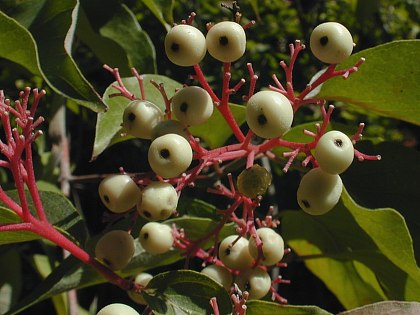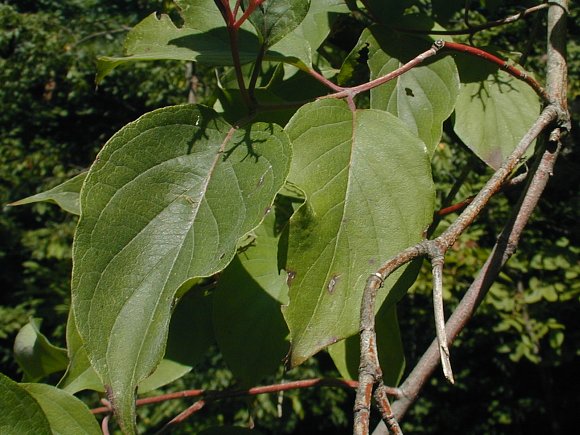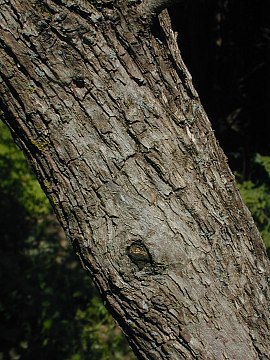Description: This woody plant is a shrub or small tree up to 20' tall with ascending to spreading branches. A large specimen has a trunk with grey bark. This bark is covered with rough flattened scales that are taller than wide. The thin grey bark of branches is often covered with scattered small bumps. Young branchlets and twigs are reddish brown and pubescent. The opposite leaves are up to 5" long and 2" across; they are ovate and smooth along their margins. The upper surface of each leaf is green, rough-textured, and sparingly covered with fine appressed hairs; there are 3-5 pairs of lateral veins that curve toward the outer margins of the leaf. The lower surface of each leaf is whitish green and densely short-pubescent (see photo). At the base of each leaf, there is a slender petiole up to 1" long.

Cymes of white flowers develop from the axils of the leaves. Each cyme is about 2-4" across and either gently rounded or flattened at the top. Each white flower is about ¼" across; it has 4 lanceolate petals, 4 stamens, and a pistil with a single style. The blooming period occurs during the late spring or early summer for about 2-3 weeks. The flowers are replaced by white fleshy drupes, which ripen during the late summer or early fall. At this time, the peduncle and pedicels of the corymb become bright scarlet. Each drupe is about ¼" across and globoid in shape; it contains a single stone. The root system normally consists of a woody branching taproot. However, if this woody plant is subjected to disturbance, it may develop suckers or underground runners that send up vegetative shoots. These vegetative shoots can develop into a colony of multistemmed shrubs.

Cultivation: This adaptable woody plant is typically found in partial sun and moist to slightly dry conditions. The soil can contain loam, clay-loam, or rocky material.
Range & Habitat: The native Rough-Leaved Dogwood (Cornus drummondii) is occasional to locally common in most areas of Illinois, except the NE, where it is absent or uncommon (see Distribution Map). Habitats include upland rocky woodlands, openings in mesic woodlands, openings in floodplain woodlands, wooded areas along rivers or streams, savannas, woodland borders, and fence rows. This woody plant is one of the invaders of tallgrass prairies.
Faunal Associations: Information on pollen ecology for Rough-leaved Dogwood is somewhat limited, but little carpenter bees (Ceratina), large carpenter bees (Xylocopa), leaf-cutter bees (Megachile), Halictid bees, and Andrenine bees suck nectar or collect pollen from the flowers. Ants visit the flowers for nectar, but they are non-pollinating, while a variety of beetles either suck nectar or collect pollen from them (Smith et al., 2012; Wilhelm & Rericha, 2017; MacRae, 1991). Other insects feed destructively on the wood, foliage, plant sap, and other parts of dogwood trees or shrubs (Cornus spp.). These insect feeders include larvae of long-horned beetles (Cerambycidae), leaf beetles, weevils, larvae of gall flies, plant bugs, aphids, the Dogwood Spittlebug (Clastoptera proteus), leafhoppers, the Dogwood Scurfy Scale (Chionaspis corni) and other armored scales, mealybugs, larvae of sawflies, thrips, larvae of many moths, and larvae of a butterfly, the Spring Azure (Celastrina ladon). See the Insect Table for a more complete list of these species. A large number of birds are partial to the fruit of dogwood trees or shrubs; this is in part because of their relatively high fat content and calories. Bird species that eat their fruit include the Wood Duck, American Crow, upland gamebirds, woodpeckers, thrushes, flycatchers, vireos, and many other songbirds (see Bird table). Some of these birds also use Dogwood trees or shrubs for protective cover and nesting sites. Mammals consume various parts of Rough-leaved Dogwood and other dogwood trees or shrubs. When these species grow near bodies of water, the American Beaver uses their wood and bark as a source of food and for construction materials of their lodges and dams. White-tailed Deer browse on their twigs and foliage, while the White-footed Mouse, Fox Squirrel, and American Black Bear eat the fruit and/or seeds. The bark is also used as a source of food for the Cottontail Rabbit during the winter (Martin et al., 1951/1961; Noyce & Coy, 1990).

Photographic Location: A woodland opening at Busey Woods in Urbana, Illinois.
Comments: Rough-Leaved Dogwood occurs primarily in the Midwest and the south-central states. It has rough pubescent leaves and bright white drupes; the latter disappear rapidly during the fall because of their attractiveness to wildlife. During the late spring or early summer, Rough-Leaved Dogwood produces cymes of flowers that are quite showy; they appear after the leaves have developed. An older scientific name for this species is Cornus asperifolia, which accounts for the common name. Other Cornus spp. (Dogwoods) can be distinguished from Rough-Leaved Dogwood by the shape of their leaves (more broad or more narrow), number of paired veins on each leaf, and/or color of their drupes (sometimes blue or red). Their leaves and young branchlets are usually less pubescent than those of Rough-Leaved Dogwood.